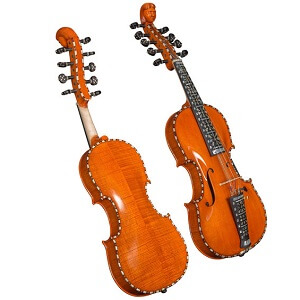Hardanger Fiddle
 Hardanger fiddle, also called Harding fiddle, Norwegian hardingfele, or hardingfela, regional fiddle of western Norway, invented in the late 17th century. It has four bowed strings positioned above four or five metal sympathetic strings. Although slightly smaller than the concert violin, the instrument is held and played in the same manner. It is used to perform rhythmically complex polyphonic music that accompanies a number of traditional Norwegian social dances, including the gangar, halling, and springar.
Hardanger fiddle, also called Harding fiddle, Norwegian hardingfele, or hardingfela, regional fiddle of western Norway, invented in the late 17th century. It has four bowed strings positioned above four or five metal sympathetic strings. Although slightly smaller than the concert violin, the instrument is held and played in the same manner. It is used to perform rhythmically complex polyphonic music that accompanies a number of traditional Norwegian social dances, including the gangar, halling, and springar.
The fiddle is one of the most common instruments, found in one form or another in nearly every part of the world. It is best known today as the violin, which found its present form in sixteenth-century Italy.
Other bowed instruments have emerged in a range of cultures from Iceland to India. One of the most charming, both in the auditory and the visual sense, is the Norwegian Hardanger fiddle (also known as the hardingfele). This close cousin of the violin developed in the Hardanger district of western Norway, southeast of the port city of Bergen. It was developed by makers who probably combined aspects of the old Norse fiðla with the viola d’amore, one of the relatives of the violin. It seems to have first appeared in the 1600s, and quickly became popular throughout the region.